Address Book
The Address Book is a feature used for storing addresses for the e-mail, I-fax, file server, fax, and group address functions. The group address feature enables you to create a group of up to 499 stored destinations as a single destination. This feature is useful when you want to send the same document to multiple destinations at one time.
The Address Book is divided into an Address Book and one-touch buttons. You can store up to 300 destinations in the Address Book and 200 destinations in the one-touch buttons, for a total of 500 destinations in the whole Address Book. Registering a destination in the Address Book saves you the effort of entering that destination’s address each time you send documents.
This section describes how to register, use, and edit the Address Book.
|
IMPORTANT
|
|
If the Language Switch setting is set to ‘On’, some characters are restricted and cannot be entered. To enter all characters, set the Language Switch setting to ‘Off’. (Configuring the Machine's Basic Settings)
|
|
NOTE
|
|
The Address Book can be exported and imported using the Remote User Interface. (Managing Jobs and Machine Data)
|
Registering the Address Book
Follow the procedures below to register destinations in the Address Book.
E-Mail Addresses
The following describes how to register e-mail addresses in the Address Book.
1
Display the Register Address screen.
You can access this screen from the Additional Functions screen or by using the Register key (shortcut key to the Register Address screen) on the Address Book screen.
If you want to access from the Additional Functions screen:
|
1
|
Press
 (Additional Functions) → [Address Book Settings]. (Additional Functions) → [Address Book Settings].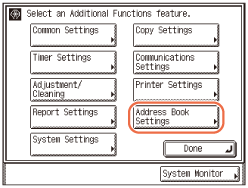 If a password has been set for the Address Book, enter the password using
 - -  (numeric keys) → press [OK]. (Setting the Send Function) (numeric keys) → press [OK]. (Setting the Send Function) |
|
2
|
Press [Register Address].
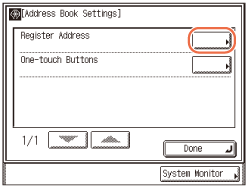 |
If you want to access using the Register key on the Address Book screen:
|
1
|
Press
 (SEND) → [Address Book]. (SEND) → [Address Book].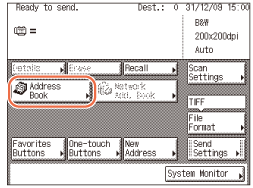 |
|
2
|
Press
 . .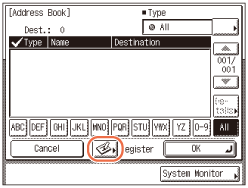 |
|
3
|
Press [Register New Address].
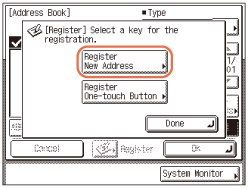 |
2
Press [Register New Add].
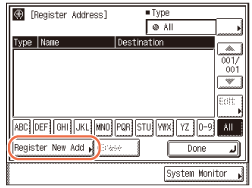
3
Press [E-mail].
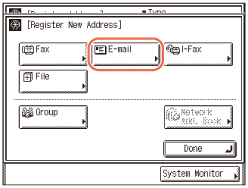
4
Enter the e-mail address (up to 120 characters) using the on-screen keyboard → press [Next].
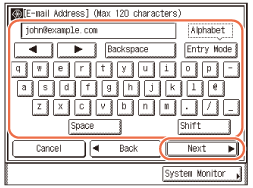
NOTE:
For instructions on how to enter characters, see Basic Operations.
5
Enter the register name (up to 16 characters) using the on-screen keyboard → press [OK].
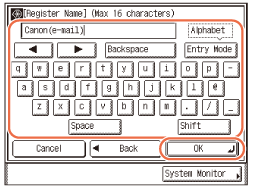
NOTE:
The first character of the register name is used for sorting the address list when you press keys such as [ABC] and [DEF] on the Address Book screen. For instructions on how to use the Address Book, see Using the Address Book.
6
Press [Done].
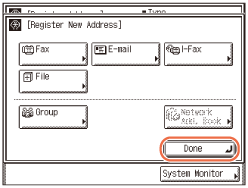
The display returns to the Register Address screen.
The e-mail address and register name you specified appear on the Register Address screen as follows:
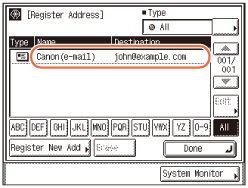
7
Press  (Reset) to return to the top screen.
(Reset) to return to the top screen.
 (Reset) to return to the top screen.
(Reset) to return to the top screen.I-Fax Addresses
The following describes how to register I-fax addresses in the Address Book.
1
Display the Register Address screen → press [Register New Add].
For help, see steps 1 and 2 in E-Mail Addresses.
2
Press [I-Fax].
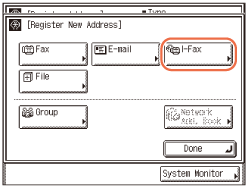
3
Enter the I-fax address (up to 120 characters) using the on-screen keyboard → press [Next].
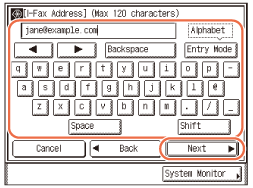
NOTE:
For instructions on how to enter characters, see Basic Operations.
4
Enter the register name (up to 16 characters) using the on-screen keyboard → press [OK].
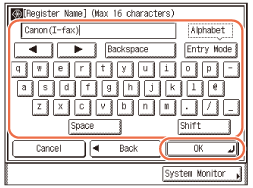
NOTE:
The first character of the register name is used for sorting the address list when you press keys such as [ABC] and [DEF] on the Address Book screen. For instructions on how to use the Address Book, see Using the Address Book.
5
Press [Done].
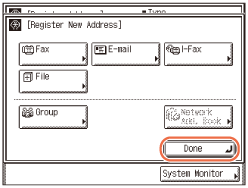
The display returns to the Register Address screen.
The I-fax address and register name you specified appear on the Register Address screen as follows:
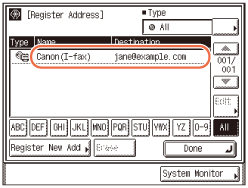
6
Press  (Reset) to return to the top screen.
(Reset) to return to the top screen.
 (Reset) to return to the top screen.
(Reset) to return to the top screen.File Server Addresses
The following describes how to register file server addresses in the Address Book.
1
Display the Register Address screen → press [Register New Add].
For help, see steps 1 and 2 in E-Mail Addresses.
2
Press [File].
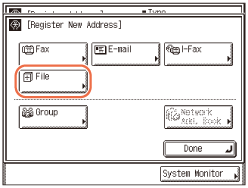
3
Press the Protocol drop-down list → select the desired server protocol.
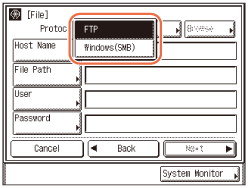
The following server protocols are available.
The table below shows the system requirements for the server that is compatible with IPv4.
|
Protocol
|
System Requirements
|
Application
|
|
FTP
|
Sun Solaris 2.6 or later, Mac OS X, or Red Hat Linux 7.2
|
-
|
|
Windows 2000 Server
|
Internet Information Services 5.0
|
|
|
Windows XP Professional
|
Internet Information Services 5.1
|
|
|
Windows Server 2003
|
Internet Information Services 6.0
|
|
|
Windows Vista/Server 2008
|
Internet Information Services 7.0
|
|
|
Windows 7/Server 2008 R2
|
Internet Information Services 7.5
|
|
|
Windows (SMB)
|
Windows 2000/XP/Vista/7/Server 2003/Server 2008
|
-
|
|
Mac OS X/UNIX/Linux
|
Samba 2.2.8a or later
|
The table below shows the system requirements for the server that is compatible with IPv6.
|
Protocol
|
System Requirements
|
Application
|
|
FTP
|
Solaris Version 9 or later, Red Hat Enterprise Linux AS/ES/WS 4.0 or later, or Mac OS X 10.3 or later
|
-
|
4
Specify a file server as the destination.
When specifying a file server, you need to set the host name, file path, user name, and password. You can use the on-screen keyboard to set these items, or use the Browse key on the File screen to specify a file server if [Windows (SMB)] is selected as the server protocol in step 3. With the Browse key you can search for and specify a file server connected to a specific network.
If you use the on-screen keyboard:
|
1
|
Press [Host Name].
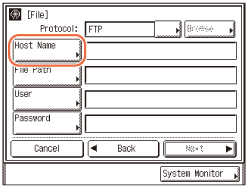 A host name is a name assigned to a host computer that provides services on the Internet. A specific host name is assigned to each host computer to specify it on the Internet. In this entry box, enter the name of the file server on the network as the destination of the send job.
|
|
2
|
Enter the host name (up to 47 characters or 120 characters when [Windows (SMB)] is selected as the server protocol) using the on-screen keyboard → press [OK].
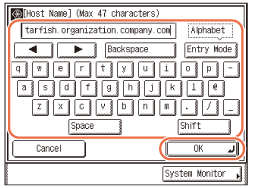 |
|
3
|
Press [File Path].
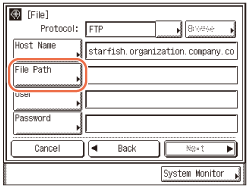 A file path is a series of characters that signify the location of the folder. Specify a folder in the file server as the destination of the send job.
|
|
4
|
Enter the file path (up to 120 characters) using the on-screen keyboard → press [OK].
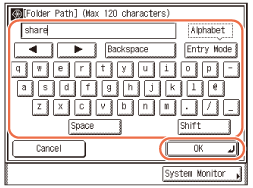 |
|
5
|
Press [User].
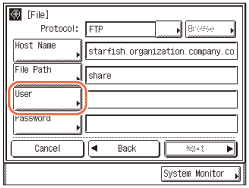 |
|
6
|
Enter the user name (up to 24 characters) using the on-screen keyboard → press [OK].
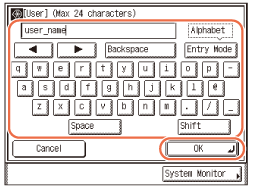 |
|
7
|
Press [Password].
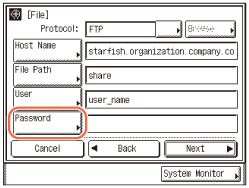 |
|
8
|
Enter a password (up to 24 characters or 14 characters when [Windows (SMB)] is selected as the server protocol) using the on-screen keyboard → press [OK]. After pressing [OK], the characters that you enter for the password are displayed as asterisks (********) on the [File] screen.
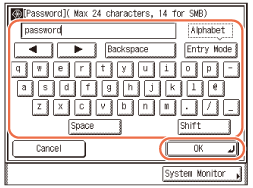 |
|
IMPORTANT
|
|
If Language Switch in Common Settings is set to ‘On’, the characters entered in [Host Name] and [File Path] may not be displayed correctly, so you may not be able to refer to them.
|
|
NOTE
|
|
For instructions on how to enter characters, see Basic Operations.
If you are sending to an iW Document Manager* folder, set the FTP server address specified in iW Gateway as the destination. Using iW Document Manager and the Send function of the machine enables you to manage digitized paper documents and computer data on the network. For more information on the iW Document Manager, see the appropriate iW Gateway documentation.
* a document management system provided by Canon
|
If you use the Browse key:
|
1
|
Press [Browse].
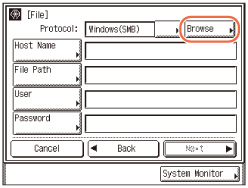 IMPORTANT:
After turning the main power ON, you must wait for the time set in Startup Time Settings to elapse before pressing [Browse]. Network transmission is not possible until this startup time has elapsed. (Other System Settings)
|
|
2
|
Select the desired workgroup → press [Down].
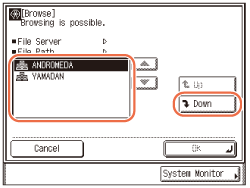 Press [
 ] or [ ] or [ ] to scroll to the desired workgroup if it is not displayed. ] to scroll to the desired workgroup if it is not displayed. |
|
3
|
Select the desired file server → press [Down] or [OK].
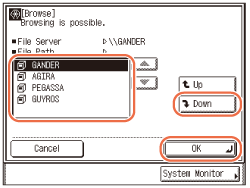 If you want to send scanned documents in a specific folder in the selected file server, press [Down] → select the desired folder → press [OK]. If not, press [OK].
|
NOTE:
If the Enter Network Password screen is displayed, enter your user name and network password → press [OK].
For instructions on how to enter characters, see Basic Operations.
5
Confirm your settings → press [Next].
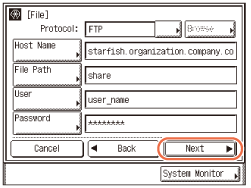
6
Enter the register name (up to 16 characters) using the on-screen keyboard → press [OK].
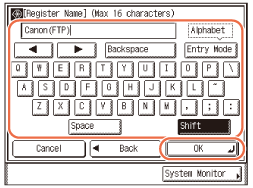
NOTE:
The first character of the register name is used for sorting the address list when you press keys such as [ABC] and [DEF] on the Address Book screen. For instructions on how to use the Address Book, see Using the Address Book.
7
Press [Done].
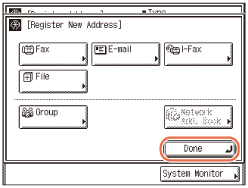
The display returns to the Register Address screen.
The file server address and register name you specified appear on the Register Address screen as follows:
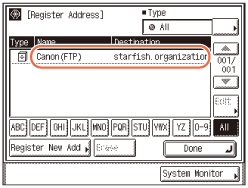
8
Press  (Reset) to return to the top screen.
(Reset) to return to the top screen.
 (Reset) to return to the top screen.
(Reset) to return to the top screen.Fax Numbers
The following describes how to register fax numbers in the Address Book.
1
Display the Register Address screen → press [Register New Add].
For help, see steps 1 and 2 in E-Mail Addresses.
2
Press [Fax].
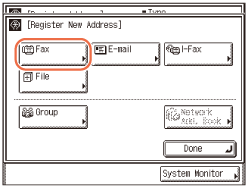
3
Enter the fax number (up to 120 characters) using  -
-  (numeric keys).
(numeric keys).
 -
-  (numeric keys).
(numeric keys).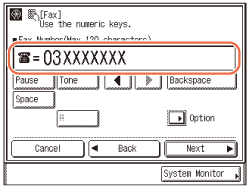
|
|
[Pause]:
|
Press to insert a pause of several seconds in the fax number you are dialing. If you insert a pause within the fax number, the letter <p> is displayed between the numbers. If you insert a pause at the end of the fax number, the letter <P> appears. When dialing an overseas number, insert a pause after the international access code and at the end of the fax number. (Dialing an Overseas Number)
|
|
[Tone]:
|
Press when you want to directly call an extension line that is connected to a PBX (Private Branch eXchange), which accepts only tone dialing. If you press [Tone], the letter <T> appears.
|
|
|
[R]:
|
Press to use the R-key. (Calling from an Extension)
|
|
|
[
 ] [ ] [ ]: ]: |
Press to move the position of the cursor.
|
|
|
[Backspace]:
|
Press to delete the number immediately to the left of the cursor.
|
|
|
[Space]:
|
Press to insert a space between numbers.
|
|
|
[Option]:
|
Press to specify optional settings in the next step.
|
IMPORTANT:
You cannot insert a pause at the beginning of a number.
NOTE:
For instructions on how to enter characters, see Basic Operations.
The pause time differs in length, depending on whether it is entered in the middle or at the end of a fax number.
The pause time entered in the middle of a fax number (lower-case p) is set to two seconds long by default. This can be changed to any length between 1 and 15 seconds. (Adjusting the Pause Time)
The pause time entered at the end of a fax number (upper-case P) is set to 10 seconds long. (This length cannot be changed.)
Two or more pauses can be entered consecutively.
You can press  (Clear) to clear your entry.
(Clear) to clear your entry.
 (Clear) to clear your entry.
(Clear) to clear your entry.4
Press [Option].
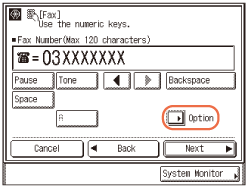
You can specify the following optional settings:
|
|
[Sending Speed]:
|
Adjusts the transmission speed. Available speeds are ‘33600 bps’, ‘14400 bps’, ‘9600 bps’, and ‘4800 bps’. If your document transmissions are slow in starting, this may mean that the telephone lines in your area are slow. Select a slower speed.The default setting is ‘33600 bps’.
|
|
[Long Distance]:
|
Specifies long distance settings. Available settings are ‘Domestic’, ‘Long Distance (1)’, ‘Long Distance (2)’, and ‘Long Distance (3)’. Use ‘Domestic’ for dialing domestic (local) telephone numbers. Use ‘Long Distance (1)’ if communication errors frequently occur when you make overseas calls (when the overseas telephone number is registered in the Address Book). If errors persist, try using ‘Long Distance (2)’ or ‘Long Distance (3)’. The default setting is ‘Domestic’.
|
|
|
[ECM TX]:
|
Sends documents with ECM (Error Correction Mode). ECM reduces the effect of system and line errors on documents that may occur when sending or receiving with another fax machine that supports ECM. For more information, see Sending with Error Correction Mode (ECM Transmission). The default setting is ‘On’.
|
If you want to specify [Sending Speed]:
|
1
|
Press [Sending Speed].
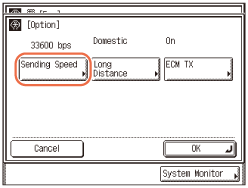 |
|
2
|
Select the desired transmission speed → press [OK].
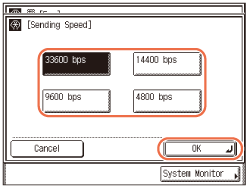 |
If you want to specify [Long Distance]:
|
1
|
Press [Long Distance].
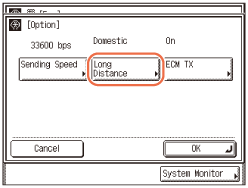 |
|
2
|
Select the type of call → press [OK].
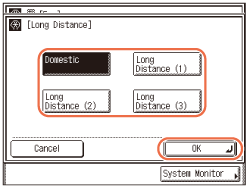 |
If you want to specify [ECM TX]:
|
1
|
Press [ECM TX].
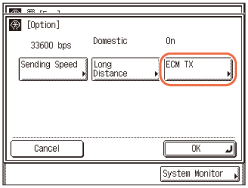 |
|
2
|
Select [On] or [Off] → press [OK].
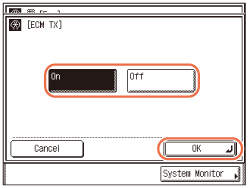 |
5
Press [OK].
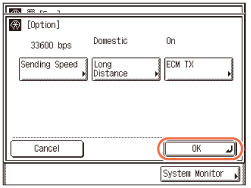
6
Press [Next].
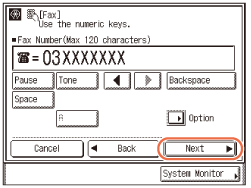
7
Enter the register name (up to 16 characters) using the on-screen keyboard → press [OK].
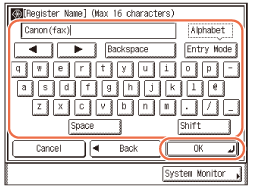
NOTE:
The first character of the register name is used for sorting the address list when you press keys such as [ABC] and [DEF] on the Address Book screen. For instructions on how to use the Address Book, see Using the Address Book.
8
Press [Done].
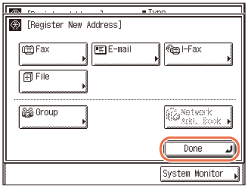
The display returns to the Register Address screen.
The fax address and register name you specified appear on the Register Address screen as follows:
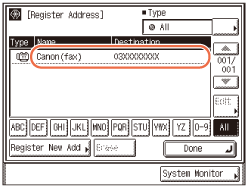
9
Press  (Reset) to return to the top screen.
(Reset) to return to the top screen.
 (Reset) to return to the top screen.
(Reset) to return to the top screen.Group Addresses
The following describes how to register group addresses in the Address Book.
|
IMPORTANT
|
|
If you want to store a group address, the destinations such as e-mail addresses and file server addresses must be stored in the Address Book beforehand.
|
|
NOTE
|
|
You cannot register a group address in a group address.
|
1
Display the Register Address screen → press [Register New Add].
For help, see steps 1 and 2 in E-Mail Addresses.
2
Press [Group].
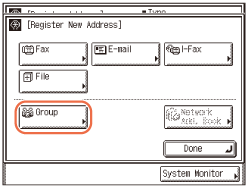
3
Press [Address Book].
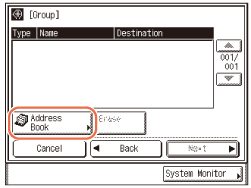
4
Select all the destinations you want to register in a group address → press [OK].
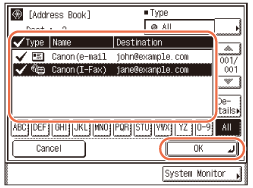
Press [ ] or [
] or [ ] to scroll to the desired destination if it is not displayed.
] to scroll to the desired destination if it is not displayed.
 ] or [
] or [ ] to scroll to the desired destination if it is not displayed.
] to scroll to the desired destination if it is not displayed.NOTE:
To cancel a selected destination, select the destination again to clear the check mark.
For instructions on how to use the Address Book, see Using the Address Book.
5
Confirm the selected destinations → press [Next].
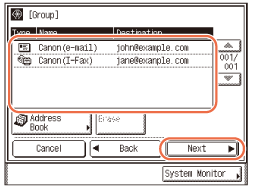
If you want to delete a destination, select the destination to be deleted → press [Erase].
6
Enter the register name (up to 16 characters) using the on-screen keyboard → press [OK].
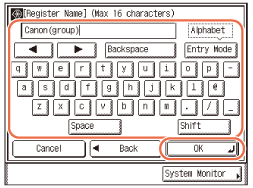
NOTE:
For instructions on how to enter characters, see Basic Operations.
The first character of the register name is used for sorting the address list when you press keys such as [ABC] and [DEF] on the Address Book screen. For instructions on how to use the Address Book, see Using the Address Book.
7
Press [Done].
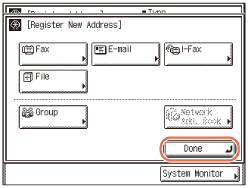
The display returns to the Register Address screen.
The number of destinations registered in the group address and register name you specified appear on the Register Address screen as follows:
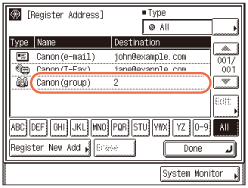
8
Press  (Reset) to return to the top screen.
(Reset) to return to the top screen.
 (Reset) to return to the top screen.
(Reset) to return to the top screen.Using the Address Book
Follow this procedure to specify destinations using the Address Book.
1
Press  (SEND) → [Address Book].
(SEND) → [Address Book].
 (SEND) → [Address Book].
(SEND) → [Address Book].
2
Select the destination from the Address Book list.
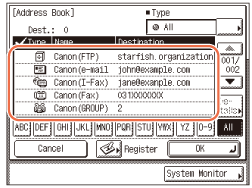
You can select multiple destinations.
The following keys on the screen are also available as necessary:
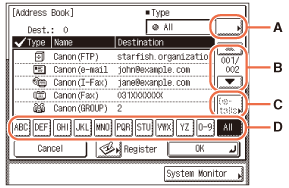
|
A
|
Press to restrict the type of destinations displayed in the Address Book list.
[All]: Displays all destinations registered in the Address Book.
[Group]: Displays the destinations registered as group addresses. [Fax]: Displays the registered fax destinations. [E-mail]: Displays the registered e-mail destinations. [I-Fax]: Displays the registered I-fax destinations. [File]: Displays the registered file server destinations. [One-touch]: Displays the destinations registered in one-touch buttons. |
|
B
|
Press to scroll the Address Book list up or down.
|
|
C
|
Press to display the detailed information of a selected destination.
|
|
D
|
Press (e.g., [ABC]) to display the individual keys for each letter or number. You can select a letter or number to restrict the displayed range of entries. Press [All] to return to the full address list.
|
NOTE:
If the register name is longer than 15 characters, the first 15 characters are displayed in the Name column in the Address Book.
To cancel a selected destination, select the destination again to clear the check mark.
The destinations you can specify may vary depending on the settings under <Send Restriction Settings>. (Customizing Settings) For example, if E-mail Send is set to ‘Do not allow’ or ‘Only allow sending to own address’, e-mail addresses and I-fax addresses are not displayed in the Address Book list.
If the settings under <When Sending File to Address Registered in Address Book> are configured to display an authentication screen, do not specify multiple file server addresses at the same time. (Customizing Settings) If you specify multiple file server addresses, an error message appears when you press  (Start) in step 4.
(Start) in step 4.
 (Start) in step 4.
(Start) in step 4.3
Press [OK].
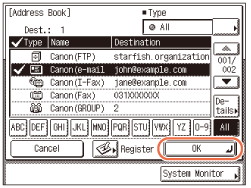
The selected destination appears on the top screen.
If you want to check the selected destination:
|
1
|
Press [Details].
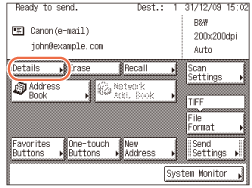 If the selected destination is a group address, select one destination at a time → press [Details].
|
|
2
|
Check the destination’s information → press [Done].
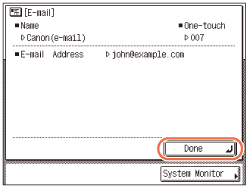 If the selected destination is a group address, press [Done] twice.
The display returns to the top screen.
|
If you want to delete the selected destination:
|
1
|
Press [Erase].
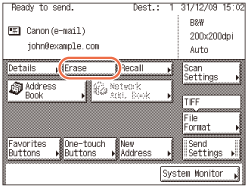 The selected destination is deleted from the destination list.
|
4
Specify the scan settings, send settings, and press  (Start) to send documents.
(Start) to send documents.
 (Start) to send documents.
(Start) to send documents.NOTE:
For the basic procedures for sending documents, see Basic Sending Methods.
If the settings under <Authentication Method> in <SMTP Authentication Settings> are configured to display an authentication screen, the Enter Network Password screen appears when you press  (Start) to send e-mails or I-faxes. (Customizing Settings) Specify the user name and password → press [OK].
(Start) to send e-mails or I-faxes. (Customizing Settings) Specify the user name and password → press [OK].
 (Start) to send e-mails or I-faxes. (Customizing Settings) Specify the user name and password → press [OK].
(Start) to send e-mails or I-faxes. (Customizing Settings) Specify the user name and password → press [OK].If the settings under <When Sending File to Address Registered in Address Book> are configured to display an authentication screen, the Enter Network Password screen appears when you press  (Start) to send documents to a file server. (Customizing Settings) Specify the user name and password → press [OK].
(Start) to send documents to a file server. (Customizing Settings) Specify the user name and password → press [OK].
 (Start) to send documents to a file server. (Customizing Settings) Specify the user name and password → press [OK].
(Start) to send documents to a file server. (Customizing Settings) Specify the user name and password → press [OK].Editing/Deleting the Registered Information in the Address Book
Follow this procedure to edit or delete the registered information in the Address Book.
1
Display the Register Address screen.
For help, see step 1 in E-Mail Addresses.
2
Select the destination to be changed or deleted.
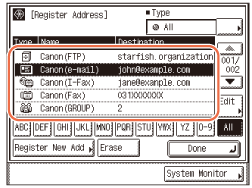
You cannot select multiple destinations at the same time.
The following keys on the screen are also available as necessary:
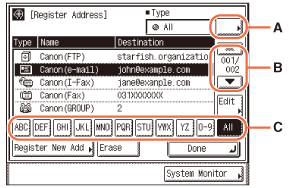
|
A
|
Press to restrict the type of destinations displayed in the Address Book list.
[All]: Displays all destinations registered in the Address Book.
[Group]: Displays the destinations registered as group addresses. [Fax]: Displays the registered fax destinations. [E-mail]: Displays the registered e-mail destinations. [I-Fax]: Displays the registered I-fax destinations. [File]: Displays the registered file server destinations. |
|
B
|
Press to scroll the Address Book list up or down.
|
|
C
|
Press (e.g., [ABC]) to display the individual keys for each letter or number. You can select a letter or number to restrict the displayed range of entries. Press [All] to return to the full address list.
|
NOTE:
If the register name is longer than 15 characters, the first 15 characters are displayed in the Name column in the Address Book.
To cancel a selected destination, select the destination again to clear the check mark.
The Address Book list includes the destinations registered in one-touch buttons. If you select these destinations in this step, you cannot change or delete them in the following steps. For instructions on how to change or delete the destinations registered in one-touch buttons, see Editing/Deleting the Registered Information in the One-Touch Buttons.
3
Change or delete the registered information of the selected destination.
If you want to change the registered information:
|
1
|
Press [Edit].
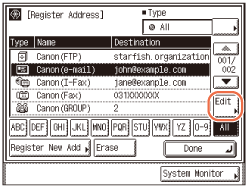 The current settings for the selected destination appear.
|
|
2
|
Change the registered information → press [OK].
The display returns to the Register Address screen.
|
NOTE:
For instructions on how to register the Address Book, see Registering the Address Book.
If you want to delete the registered information:
|
1
|
Press [Erase].
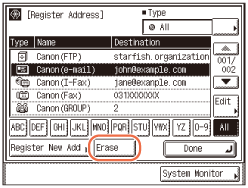 |
|
2
|
Press [Yes].
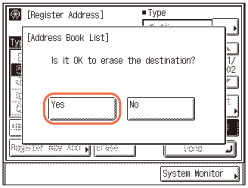 The message <Erased.> appears for approximately two seconds on the touch panel display.
The registered information is deleted.
|
4
Press  (Reset) to return to the top screen.
(Reset) to return to the top screen.
 (Reset) to return to the top screen.
(Reset) to return to the top screen.